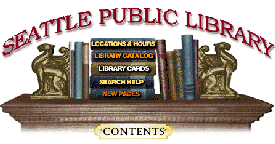The Future

The future of the Seattle Public Library is under intense public debate at the time of this writing. Nevertheless, the observations that the Council staff made on its site visit in May are still relevant, despite the library’s change in leadership. Public access Internet services have increased the library’s visibility within the city, as have recently established services for underserved populations and other library experiments in information technology. Given the number and variety of library programs and services, and the fact that the library is visible to different parts of the community for different reasons, the library must manage its image carefully. The library wants to keep its commitment to traditional services as visible to the voters and city administrators as the services targeted to underserved populations. It also wants to keep its substantial investment in books as visible as its investments in information technology. Keeping the voters of today and tomorrow well informed about the full range of publicly-funded library programs and services continues to challenge all libraries. However, these activities present a special challenge to a trail-blazing institution such as the Seattle Public Library.
We observed that members of the library’s management team held differing views of the library’s future. The issues that define these differing visions are multifaceted, complex, and sometimes conflicting. With differing visions of the library’s future it is hard, if not impossible, to move the library forward. Finding a vision for the future of the library that all can share–library staff, city officials, the library board, and community members–will be one of the greatest challenges that will face a new library administration in Seattle.
To our knowledge, the Seattle Public Library is the only public library that operates a research and development operation for information technology. The Center for Technology in the Public Library has been conducting experiments to better understand the information needs of the community and the opportunities for serving those needs through technology. As the center and its projects mature, the library faces an ongoing challenge to integrate what has been learned through research and experimentation into library service objectives and program development. At the time of the Council’s site visit, a highly pragmatic philosophy of technology development prevailed, which was best expressed at the library by the colloquialism: “you won’t understand something unless you build it and try it.” This attitude also reflects a high level of responsiveness to the community. It will be instructive for both library and city planning to analyze the effects on the community of the library’s investments in technology and to share that knowledge among departments within the library and the city.
Libraries and their funders are eager to learn how the increased availability of public information affects a community. What effect do highly developed library services for children have on a community? How will a city of readers and lifelong learners function, and what are the implications for democratic processes? The Seattle Public Library has created environments from which we can begin to discern answers to some of these questions. Evaluating this library’s efforts will reveal useful information from which other communities and libraries can benefit. Communities across the country will be the richer for it.
From the publication Public Libraries, Communities, and Technology: Twelve Case Studies, published by The Council on Library Resources, ©1996. For more information contact
The Council on Library Resources, 1400 16th Street NW,
Suite 715, Washington DC, 20036. Phone (202) 939-3370. Fax (202) 939-3499.

